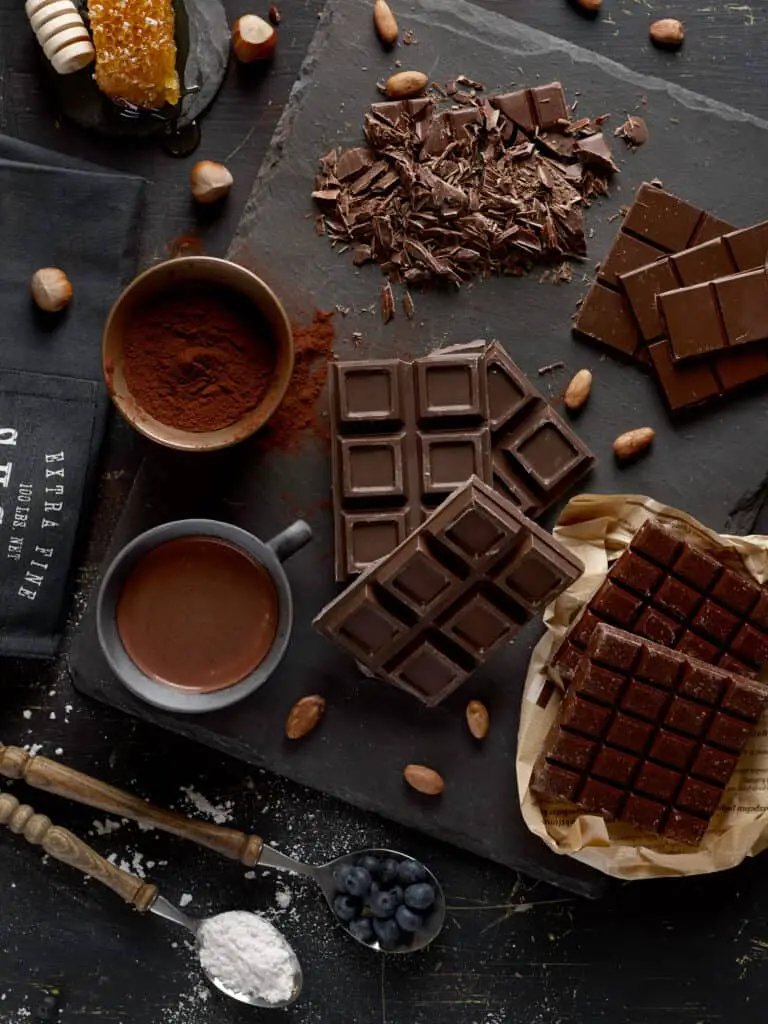When it comes to getting coffee, cappuccinos and lattes are pretty popular drink choices, possibly the most commonly chosen of all of the options. Yet, most people don’t know much about the similarities and differences between cappuccinos and lattes. The comparison is quite fascinating though!
Cappuccinos and lattes are similar in how they use the same three ingredients, and they are different in the amounts those three ingredients are used. Cappuccinos are layered and lattes are mixed. Also, lattes are richer and creamier and have a more subtle espresso flavor.
To further evaluate the differences and similarities between the cappuccino and the latte, let’s look into how cappuccinos and lattes are made by some popular coffee companies like The Coffee Bean, Starbucks, L’OR Espresso, The Coffee Bros, and The Coffee Brewers. Because they are among the more familiar places people go to for coffee, they can certainly bring valuable insight into the cappuccino and latte comparison.
Cappuccino and Latte Comparison: The Coffee Bean Perspective
When The Coffee Bean makes cappuccinos and lattes, there are a few key differences unique to them. First, let’s look at how The Coffee Bean makes their cappuccinos, and then how they make their lattes.
When preparing a cappuccino for a customer, they begin by putting espresso shots at the bottom (either one or two shots, typically two, depending on what size the cappuccino being purchased is) which serves as the foundation for the cappuccino.
After putting in the espresso shots, they steam the milk they use to make it more rich and creamy, and then they add that to the cappuccino. They conclude by adding foamed milk on the top, which is basically the equivalent of the cherry on top with ice cream. The prime goal at the finish is to have a 1 to 1 ratio for the foam to the espresso and steamed milk. Due to the ratio The Coffee Bean uses with their cappuccinos, they have a pretty strong flavor from how powerful the espresso flavor is.
When The Coffee Bean makes their lattes, they use steamed milk similar to the way they make cappuccinos. That particularly helps with decreasing the strength of the espresso taste. The espresso actually happens to be the standard foundation at the bottom of the latte and sets the tone for the drink. More particularly, they start from the beginning of making the latte by adding in espresso shots.
Once the steamed milk has been combined, the latte is at a perfect 1 to 2 ratio for the espresso to the steamed milk. That is perhaps the biggest difference between The Coffee Bean’s cappuccinos and their lattes: there is far more steamed milk in the latte, making it less bitter and far more sweet and creamy.
They finish preparing and making the latte by adding foamed milk on the top, another thing that is comparable to the way that The Coffee Bean makes their cappuccinos. However, there is a minimal layer of foamed milk in the latte, especially when it is compared to the large amount of foamed milk they use in their cappuccino. Also, oftentimes, people will request to have flavor shots added to their latte. Vanilla and hazelnut appear to be the most common flavor shots.

They also use whole milk in their cappuccinos, but the lattes do not have whole milk in them. In fact, the cappuccino is put together in layers which is primarily because all of the ingredients in the drink are in equal amounts. That isn’t the case for lattes though. Instead, The Coffee Bean has an unequal ratio with the ingredients, and they are blended as opposed to being layered like the cappuccino is.
In addition, when looking at the difference between cappuccinos and lattes from a health perspective, there is a decent difference in calories between the two. In The Coffee Bean’s 12 ounce cappuccino, there are 130 calories. However, in the Coffee Bean’s 12-ounce lattes, there are 210 calories. Considering that is with the cappuccino and the latte being the same size, and not even that big of a size for that matter, a difference of 80 calories is quite a lot!
For more information, refer to The Coffee Bean website.
Cappuccino and Latte Comparison: The Starbucks Perspective
Everyone loves Starbucks, and they are incredibly famous for their coffee. There are a handful of differences in how they make their cappuccinos and how they make their lattes. A big focus for Starbucks is the weight of the cappuccino or the latte. That primarily has to do with how the two drinks are set up.
Much the same as The Coffee Bean, Starbucks prepares their cappuccino by layering the ingredients. They start by adding in the espresso shot (or shots) which, again, can vary in amount based on the size of the cappuccino they are making. That is followed by adding the steamed milk and then topped by adding the foamed milk.
When Starbucks prepares their foamed milk for their cappuccinos, lattes, and some other drinks, they do it in a way that endeavors to make the foamed milk light and airy even though the foamed milk layer in their cappuccino is fairly deep.
A Starbucks latte shares an incredibly similar story, both to their cappuccino and the Coffee Bean’s latte. The espresso at the base doesn’t end up having nearly as strong of a flavor because there isn’t as much espresso in the latte as there is in the cappuccino. Plus, following suit, there is also a very small and thin layer of foamed milk at the top, so most of the latte consists of the milky, rich steamed milk.

There were obviously a lot of similarities in how Starbucks makes their cappuccinos and lattes, and how The Coffee Bean makes their cappuccinos and lattes. However, they have some different focuses which play a factor in the outcome of the drink.
For Starbucks, they have more emphasis on having the layers of their cappuccino being more sharp, definite, and clear cut. On the other hand, they mix all of the ingredients when they make their lattes instead of blending them in the same way The Coffee Bean does, and they have the strength of the espresso taste in their latte more faint and slight than the lattes made by The Coffee Bean.
It’s how the drink was prepared and put together that makes the difference. Also, as previously mentioned, the workers are specifically trained to be attentive to the weight of the drink since Starbucks believes that to be a good indicator of how well the cappuccino or latte was prepared.
To learn more, go to the Starbucks website.
Cappuccino and Latte Comparison: The L’OR Espresso Perspective
While this business may be smaller than Starbucks, L’OR Espresso still is quite popular and has fancy products. They differ in a few ways with their cappuccinos and their lattes too, and it is quite fascinating to see the differences between their cappuccinos and lattes.
Let’s start by looking at the logistics of how L’OR Espresso makes their cappuccino:
The steamed milk makes up the first third of the cappuccino. That is very unique and specific to L’OR Espresso. Then comes from the origin of Italy with either one or two shots of espresso. The number of espresso shots that are applied is based on the drink size, and that consists of the next third of the drink.
Is the specificity of the layering sounding familiar? Lastly, the final third of the drink can be one of two options: frothed milk, or microfoam. The difference between the two options is that frothed milk is more light and airy (so there is less of it even though it takes the same amount of space), and microfoam, also known as velvety foam, is more smooth and silky in its consistency.
L’OR Espresso’s measurements for their latte are a bit unique. For starters, they have the same amount of espresso in their latte as they do in their cappuccino, so a shot or two depending on how much is needed to make up a third of the drink. They then have both of the other thirds of the latte consist of steamed milk.
That is probably why L’OR Espresso’s latte is even creamier and sweeter than most other lattes. After all, the steamed milk is the primary factor that reduces the bitterness of the natural espresso flavor and makes the latte so milky and sweet. The drink is also topped in foamed milk, but only one centimeter, which is less foamed milk than most other coffee companies typically put in their lattes.

When it comes to the factors of making cappuccinos and lattes, L’OR Espresso pays a lot of attention to the texture of the drinks. For example, there is an evident emphasis on how they want the cappuccino to be perfect both in its flavor and consistency. For lattes, the focus is placed significantly on the soft and silky foam they have as their top element.
As a result, the appearance, specifically but not only with the constancy and thickness of that foamed milk that is layered at the top, is given prominence. Interestingly, the layers of L’OR Espresso’s latte are more distinct than the other coffee companies. L’OR Espresso recommends having the cappuccino’s size range between 150 ml and 180 ml, or 5 fluid ounces to 6 fluid ounces. With their lattes, they suggest having the drink size be around 240 ml which is a little over a cup or 8 fluid ounces.
The mentioned information, and also more details on L’OR Espresso, visit their website.
Cappuccino and Latte Comparison: The Coffee Bros Perspective
The famous Coffee Bros likewise has some differences between their cappuccinos and their lattes. Turns out, ever since the espresso was invented in Italy, the cappuccino was traditionally 5 fluid ounces to 6 fluid ounces in size, and it consisted of a third of espresso, a third of steamed milk, and a third of foamed milk. Essentially, each of the three ingredients is supposed to comprise 2 fluid ounces.
As the drink grew in popularity, people began adding fun things such as delicious cacao powder, tasty cinnamon, or smooth and milky whipped cream. The way The Coffee Bros see things in regards to the cappuccino, the microfoam layer at the top should be quite dense, the strength of the espresso flavor should range from medium to strong, and the drink should be rich and level in the proportions of the ingredients.
Lattes were actually created because when American tourists would visit Italy, they would sometimes have a difficult time with how strong the flavor of the espresso was in the cappuccino. It’s always been around 8 fluid ounces in size since the beginning, but larger sizes have become more common recently.
When The Coffee Bros makes their lattes, they use the following measurements: there is one fluid ounce of espresso at the base, the middle of the drink is anywhere between 8 fluid ounces to 16 fluid ounces (depending on the size of the latte) of steamed milk, and the top layer which is composed of micro-foam, or foamed milk, it ranges from one fluid ounce to two fluid ounces in size. The Coffee Bros find that the most common and frequent flavors they are asked to add are vanilla, caramel, and chocolate.
When making the cappuccino, The Coffee Bros believes that the creaminess of the microfoam is incredibly important, perhaps one of the most important elements. In regards to The Coffee Bros and making the latte, their focus reflects how they want it to be rich and milky. They are also of the opinion that the espresso flavor should be very tame since the purpose behind the initial creation of the latte was to greatly decrease the acidity of the espresso in the drink.
The above information was found and can be further looked into at The Coffee Bros website.
Cappuccino and Latte Comparison: The Coffee Brewers Perspective

Last but not least, The Coffee Brewers is another popular place for coffee, and they give valuable insight into some differences they have in how they make their cappuccinos and how they make their lattes. They put a unique spin on how they make cappuccinos.
They begin with measuring out equal amounts of espresso and steamed milk. Then, they put the steamed milk in a special machine they have called the frothing pitcher. In the frothing pitcher, the milk is frothed which causes it to double in size. Skim milk is the preferred way to go because it ends up with a greater volume than 2% milk, or whole milk, and so on. Lastly, they pour that over the espresso finishing the making of the cappuccino.
Lattes follow a similar pattern to cappuccinos. The Coffee Brewers begin again by measuring out the espresso and the milk, but this time, there is twice as much milk as there is espresso.
Instead of frothing the milk like they do when making their cappuccinos, they heat up the milk ideally to the temperature range of 150 degrees to 160 degrees using a steam wand. The steamed milk is then combined with the espresso, and then the combination of the two ingredients is topped by any frothed milk that comes from the process of heating the milk with the steam wand. When requested, chocolate and cinnamon are added as well to both the cappuccinos and the lattes.
As is evidently seen in the information detailed above, The Coffee Brewers places great significance and value on the process of making the drink, regardless of whether the drink being made is a cappuccino or a latte. The unique process and the emphasis placed on it certainly contributes to the overall flavor of the drink.
For more information, the mentioned facts can be found on The Coffee Brewers website.
